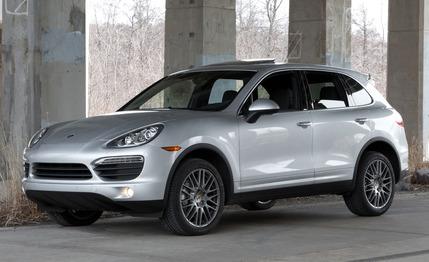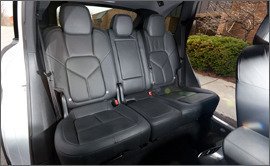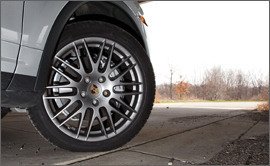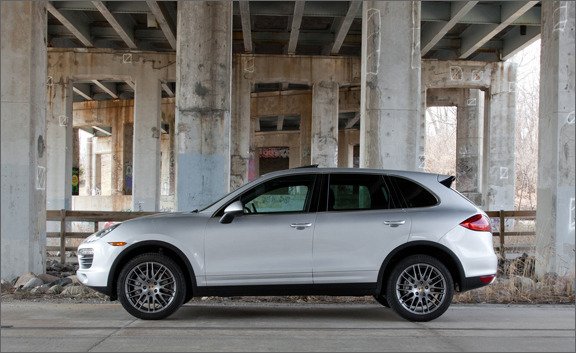 Short Take Road Test
Short Take Road Test
If you were among the more than 280,000 buyers around the globe who didn’t get worked up when Porsche introduced its first-ever SUV, now you have a reason to be upset—not because all the hateful stares from purists have finally become too much, but because the second-generation Cayenne is so much improved over the first.
Larger, but Not Lumpier
The new Cayenne is deceptively large. On the outside, its trimmer appearance makes it look much smaller than the previous version. Parked next to a current Toyota RAV4, the Cayenne looks about the same size. It is, however, not only bigger than the RAV4 but also larger in almost every measure than the original Cayenne. The wheelbase is up 1.6 inches to 114.0, the width spans another 0.4, for a total of 76.3, overall length stretches 1.9 inches to 190.8, and the new Cayenne stands 0.2 inch taller, at 67.1. As you would expect, the elaborate and handsome interior—it does an admirable job of mimicking the Porsche Panamera’s—allows for a little more wiggle room and a much-needed boost in cargo capacity. With the second-row seats upright, the Cayenne now accepts another five cubic feet of whatever you want to cram into it, bringing the total to 24 cubes. Fold the seats, and you’ll have a 60-cubic-foot void behind the front chairs.

It seems logical that the ’11 Cayenne would pack on a few pounds, but it’s actually lighter than its predecessor. Porsche engineers rejiggered the all-wheel-drive system, the chassis, the body, the electrical components, and more, yielding an overall loss of about 400 pounds model to model, according to Porsche, even with structural reinforcements helping stiffen the shell. Our scales confirm it. This test vehicle weighed 4941 pounds, 410 fewer than the last Cayenne S we tested.
Diligent Dancer
Alongside the weight loss and the striking new exterior and interior design, Porsche squeezed an additional 15 hp from the Cayenne S’s naturally aspirated 4.8-liter V-8. A new transmission with two more forward ratios—there are eight now—helps to achieve EPA ratings of 16 mpg city and 22 highway. Although it works fine by conventional-automatic standards, we feel spoiled by the PDK dual-clutch auto offered in the rest of Porsche’s range.
Nonetheless, with hp now at an even 400, the drivetrain improvements enable the Cayenne S to hit 60 mph in 5.5 seconds and clear the quarter-mile in 14.1 at 101 mph. Those numbers are an improvement of a half-second to 60 and 0.4 second and 3 mph in the quarter-mile. Notable as the Cayenne’s straight-line performance may be, it’s really the improvement in overall dynamics that makes it shine.

Dancing on a set of optional 20-inch wheels wrapped in Michelin Latitude Diamaris rubber, the Cayenne S is extremely agile. The steering requires little effort and returns enough feedback to inspire confidence near the limit, which, at 0.85 g, is pretty high for an SUV. While remaining neutral at lower cornering speeds, the Cayenne responds to extreme loads with some understeer, although not to a terribly frustrating degree. The Michelins’ adhesion also is reflected in the 170 feet the Cayenne needed to stop from 70 mph. That’s a good number for a nearly 5000-pound carton, although we would like better reporting from the pedal.
The trio of suspension settings—comfort, normal, and sport—offered by the Cayenne’s optional Porsche Active Suspension Management (PASM) does a superb job of catering to various drivers’ preferences. There is a noticeable difference in ride quality when switching from the cushier comfort mode to the firm, but not totally punishing, sport. Stability control takes some cues from PASM as well, being rather lax and allowing some fun in sport mode, in spite of not being very tolerant in comfort. Normal is, well, between the two others.

For a slight boost in the EPA ratings—and likely of greater benefit to real-world efficiency—the V-8 in the 2011 Cayenne S adds a stop/start function that shuts down the engine while the vehicle is stationary. (The function can be turned on and off with a button in the center stack.) Some of us were a little wary of how the system would perform, but we came away impressed by its quickness. We tried repeatedly to move our foot from the brake to the gas before the engine could start (left-foot braking not allowed) but rarely succeeded. Unfortunately, the system’s default setting is off, and few of our test drivers bothered to turn it on—and even fewer of us have commutes that involve sitting in traffic much, so it probably didn’t matter. Under our two-ton right feet, the Cayenne S managed only 14 mpg overall.
Watch Those Options
As with any Porsche, restraint is a requirement when ticking options boxes. We wouldn’t call the Cayenne S’s base price of $65,375 cheap, but it is almost reasonable for something with this Porsche’s blend of attributes. Our test vehicle tacked on $15,665 in extras, which counts as restraint when you consider how easy it is to ratchet an S to the scarier side of $100,000. The big setbacks were a $1690 Bose stereo upgrade, the 20-inch RS Spyder wheels for $3120, and the $7790 Premium package, which includes nav, xenon headlights, 14-way power and heated front seats, PASM, park assist, auto-dimming mirrors, and a heated steering wheel. Classic Silver Metallic paint cost another $790, satellite radio was $750, a hitch added $650, and a ski bag, $405. Porsche crests embossed on the headrests were $285; color Porsche-crest wheel-center caps were $185. (All Porsches have black-and-white crests on the center caps, but you have to pay extra to get someone to color them in.) From that list, the most essential options are PASM and the navigation system, which can also display a full-color map in one of the instrument cluster’s larger pods.
Any way you option your Cayenne S, the net result is a creation that earns the “sport” portion of the SUV label and the fabled crest on its hood. Traditionalists might still balk at the Cayenne, but if you control yourself with the options sheet, you’ll have no reason to do the same.